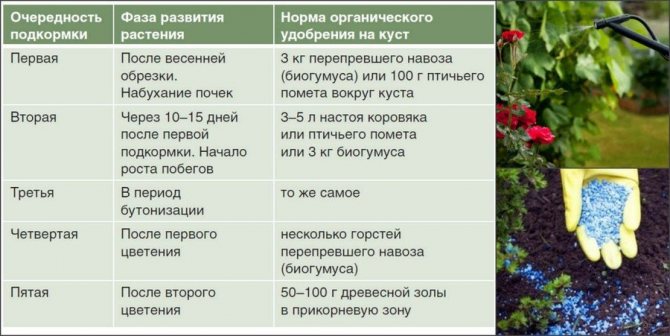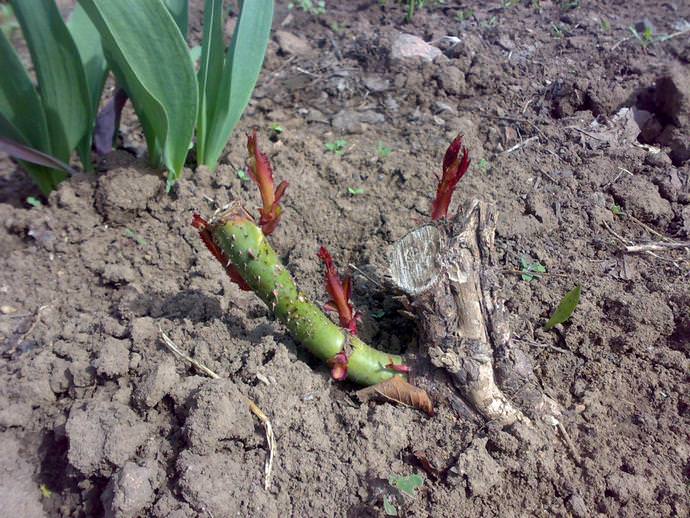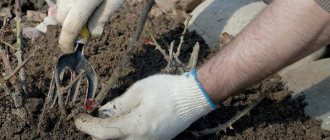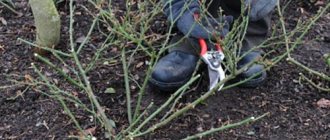The rose is called the queen of flowers for a reason. It will become an adornment of any flower bed, but for abundant flowering, a rose must be properly looked after. Our today's article is devoted to caring for roses in the spring in the country.
You will learn how to properly prune, fertilize and mulch bushes, as well as learn how to independently recognize and deal with pests and diseases.
- Chlorosis
Opening roses after winter (shelter removal)
Naturally, the first thing to do for roses in the spring is to remove their winter shelter.
And this is very important to do in the right time frame.
The main indicator that it is time to open roses is snow melting and thawing of the ground.
As for the temperature, you can open roses with the onset of positive temperatures (+3 .. + 5), in fact, otherwise the soil simply will not thaw and the snow will not melt.
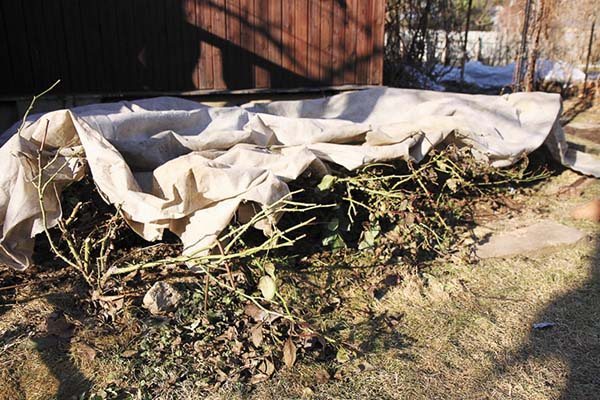
Of course, it is quite difficult to say exactly when to open roses after winter, but you can still name approximate dates (depending on the climate of the region:
Rose restoration after wintering: sanitary pruning of damaged shoots
First of all, you need to carry out the spring sanitary pruning of roses, namely, cut out all frozen, diseased and broken shoots.
Frozen shoots, usually, black and dry.


But to define freezing of the escape from within the color of its bark is sometimes impossible at once. But this can be easily checked by a slice, and if middle brown - the escape is frozen and you need it trim to healthy wood (until the middle is white).
If after 2-3 weeks, you notice that even on the left (seemingly good) shoots, the buds did not wake up, then they must be completely removed to the grafting site, freeing it to the maximum from the ground, i.e. rose grafting needs to be broken. It will also have a positive effect on the awakening of dormant kidneys.
To stimulate the awakening of dormant kidneys, it is recommended to provide increased humidity at the vaccination site, namely to create greenhouse conditions. For example, you can cover the rose with a cut 5 liter bottle and be sure to shade. As a rule, after 2-4 weeks, the buds should open and shoots will appear. But if this does not happen, then you should not despair and uproot the bush right away. Wait until autumn, because the rose is a very viable shrub.
And in addition, you can pour the remaining part of the bush after the sanitary pruning with a solution of the natural stimulant HB-101.
Video: what about roses in spring, how to help them after winter
Advice! After pruning, all cuts should be covered with garden varnish, and even better with RanNet paste.
It is also very important that you use only a sharp and well-disinfected secateurs, for example, it can be treated with chlorhexidine.
Other aspects of spring pruning
Advice! And in more detail with the rest of the main features of spring pruning of various types of roses you can read in this separate article.
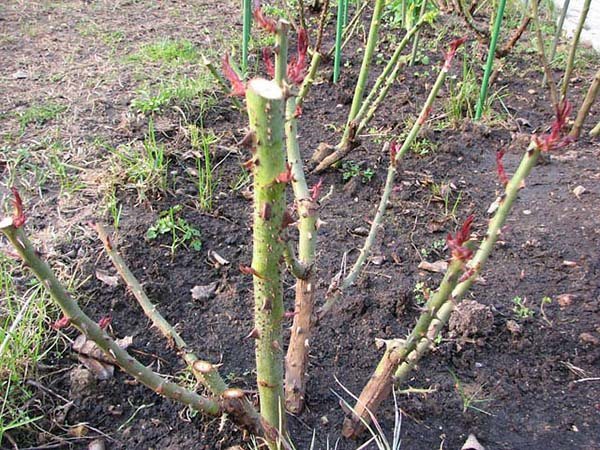

What tools do you need to trim
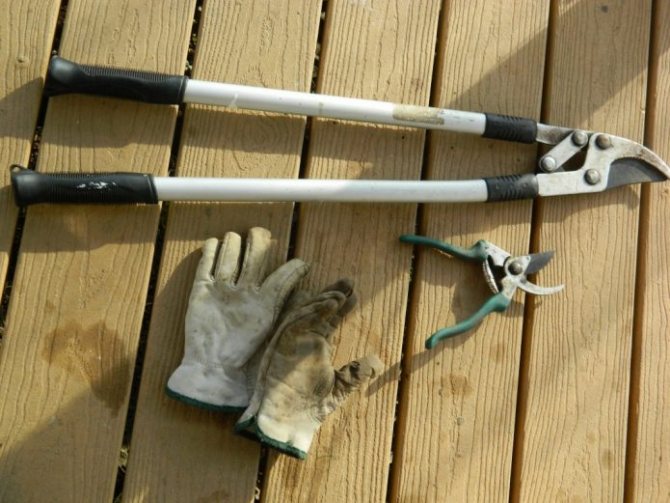

A hacksaw is used to trim stems larger than 2 cm in diameter.
The procedure requires a minimum set of tools, they are all sold in a hardware store or in a greenhouse along with a rose seedling. When buying a bush for planting, you can immediately consult with a specialist and choose the most suitable set for care.
So, to trim the bushes you need:
- garden shears and knife. They are used for processing thin young stems;
- secateurs. Used for cutting branches no more than 2.5 cm thick;
- brush cutter. The same pruner, but for thicker lignified branches. Thanks to the long handles, it is possible to reach the most distant branches. And the gardener's hands will not suffer from thorns;
- garden hacksaw. Useful if the stems of the bushes are very thick.
To process the cuts, you need to purchase a garden pitch in order to protect the rose from infection with any infection.
It is important to make sure all tools are well sharpened before trimming. The blunt point will tear the stems and the wound will heal for a long time. It is also necessary to treat the cutting part of the instrument with a disinfectant to eliminate the risk of harmful bacteria entering the cut.
Caring for the health of rose bushes: we spray
Roses are quite capricious, delicate flowers, and they, like no other, are susceptible to fungal diseases and pest attacks. The main enemies of plants are:
- ticks;
- aphid;
- caterpillars;
- beetles.
A few days after you have carried out the first spring treatment of roses, when the greenery begins its active growth, spray the plant with special preparations. The hardware store has a large selection of such products. Check with the seller in which preparation contains both a fungicide and an insecticide - this combination is optimal for the plant, moreover, it will save you money and time for processing.


Black spots on the leaves of roses are a sign of a disease.
The universal remedy will protect your roses from aphids, powdery mildew, rose rust and black spots. Spraying should be done in the evening, in calm and dry weather. Manufacturers recommend spraying plants every 2 weeks from the start of the active growth phase. But experience shows that two sprays are enough: the first - during the early spring treatment, the second - in the summer, after the roses have faded once.
If there are rosehip varieties among your roses, and you plan to eat their fruits, then you should not use synthetic insecticides and pesticides. In this case, you will need natural controls such as plant-type fungicides and insects. For example, a ladybug and her larvae can help you get rid of aphids.
The question of when to open roses in spring is very important for plants. This is a crucial period that determines their future state. The blooming of roses lasts until the first frost, the shelter protects the bushes from the cold and creates conditions for a quick entry into growth in the spring. Abundant flowering and flower development depend on the timely removal of protection.
When to open roses after winter?
It is important to clearly define the time when roses can be opened after winter shelter. With a belated process, the flowers are shaken out from excess moisture from the melting snow. At an early age, they can die from recurrent frosts. You can open roses after the snow has gone and the risk of severe cold has passed. The hibernation of roses ends with spring warming. Their buds swell, but the roots that are in the frozen ground are not yet included in the work. Therefore, in mid-March, snow is thrown onto the bushes, in April - it is removed. For each type of rose, there are nuances in spring care.
[youtube] Vus68Z_vB2o [/ youtube]
At what temperature to open roses after winter?
Thawing of the soil serves as a sign for removing the shelter. In the middle zone of the country, this happens after April 10-15.It is important to know at what temperature to open roses:
- It is generally prohibited to remove the protection in the presence of snow.
- When opening, temperature indicators at night should not show less than -2 ° C.
- During the day, the thermometer should be kept within + 10-15 ° C.
When the soil under the roses in the shelter thaws to a depth of 20-30 cm, the protection can be sequentially removed. Do this in the evening to avoid sunburn of young shoots and dry them with the wind. At the initial stage, the ends of the shelter are slightly opened, the next day - the northern and eastern sides. On the third day, the structure is completely eliminated and the roses are shaded with paper or spruce branches.
When to open a climbing rose after winter?
Not all inexperienced growers know when to open a climbing rose after winter and how to do it correctly. Often, such undersized and ground cover varieties in the fall are high in soil or sand, covered with spruce branches, foliage, sawdust, and covered with frame material from above. When to open climbing roses in spring:
- In late March - mid-April, the covering material is lifted and the upper tier, which has compacted and packed over the winter, is loosened.
- Then the bushes are closed again, leaving a gap at the edges for the passage of air, so that they "breathe" and moisture evaporates.
- After 5-7 days, a frame shelter opens from the east or north side.
- After another 2 days, you can open all the roses and rake leaves, sawdust, mulch from the ground.
- Climbing roses are raised on the supports when the constant warmth comes. This cannot be done right away - if a sharp cold snap comes, then the bush can be immediately covered with a covering material like agrofibre or spunbond.
When to open a standard rose after winter?
Decorative standard roses are tall and have an extensive crown. For the winter, they are bent down, buried in, covered with arcs covered with cardboard, roofing felt. In spring, standard roses require special attention. They are raised only after thawing and warming up the soil, when the roots begin to work. When asked when to open standard roses, experienced florists give advice to do this from the end of April. The process takes place in several stages:
- In the first half of March, snow is removed from the shelters and branch grooves are made.
- In mid-April, it is worth opening the ends of the arch for ventilation.
- After a day, you can open two sides of the shelter.
- On the third day, all the material is removed, leaving spruce branches or straw to protect the branches from sunburn. These roses suffer from desiccation very much, therefore, in the first sunny days, their crown must be protected.
- Shading is removed in mid-May, when the heat is finally established. After that, the branches can be lifted from the ground and fastened to the supports.
When to open the cuttings of roses under the jars?
Often, to propagate roses for the winter, cuttings are dropped in the garden and covered with jars - this is how a micro greenhouse is created. Care consists in timely watering, sprouts on the plant appear in about a month. For the winter, the vessel must additionally be covered with fallen leaves, grass, tops from the garden. When asked when it is possible to open roses from under a jar for next year, experienced flower growers advise to do it later - at the end of May, when a stable heat comes, you can not open them until summer.
Opened roses in spring - what to do next?
After opening the bushes, you need to take proper care of the roses in the open field:
- Trim dry, broken and frostbitten stems, the dark ends are trimmed to the green part - this is cosmetic pruning. Healthy shoots are treated with 1% copper sulfate, the plant is shaded until mid-May.
- After a few weeks, the crown is molded according to the rules of each variety.
- A few days later, feeding is carried out with infusion of mullein 1:10. The fertilizer is kept in a container for 2 weeks and the bushes are watered, diluted with water 1: 2. In the absence of organic matter, a complex mineral composition can be applied - scattered over the surface of the earth.
- The bushes are poured under the root with heated water to put the roots into operation - 10-15 liters per plant.
- When young shoots appear, they are re-treated with a 1% solution of copper sulfate. When aphids appear, Actellik or another insecticide is used.
- Roses are spud, long branches are fixed on supports.
Preventive treatment
Caring for roses is a matter of year-round importance: fertilizing a bush in summer is no less important than sheltering a plant in autumn from frost, pruning branches after winter, or treating diseases and pests in spring.


Immediately after opening and pruning in spring, roses are prevented from powdery mildew, rust, aphids and spider mites.
To flush frostbites from possible infections and fungi, a solution is prepared in the proportion of 100 g of copper sulfate with a concentration of 3% per bucket of warm water, which is used to spray the bush and the root part of the soil.
Yes, the process of growing roses is laborious and time-consuming, but what tenderness the beautiful delicate buds and almost imperceptible aroma bring.
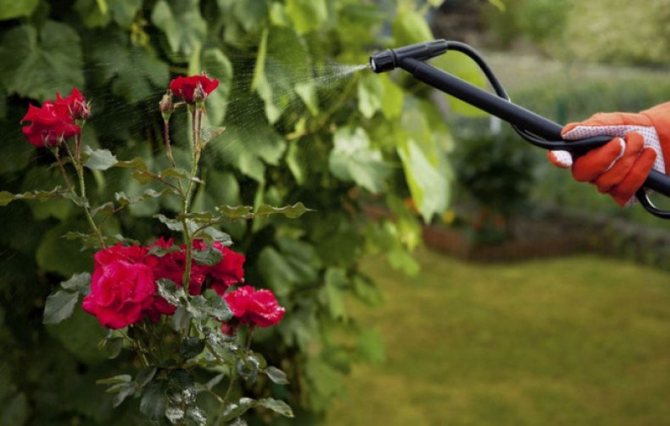

A true gardener will never regret the time and effort spent looking at his result. We wish you the same after reading the article!
The question of when to open roses in spring is very important for plants. This is a crucial period that determines their future state. The blooming of roses lasts until the first frost, the shelter protects the bushes from the cold and creates conditions for early growth in spring. Abundant flowering and flower development depend on the timely removal of protection.
When to open roses after winter?
It is important to clearly define the time when roses can be opened after winter shelter. With a belated process, the flowers are shaken out from excess moisture from the melting snow. At an early age, they can die from recurrent frosts. You can open roses after the snow has gone and the risk of severe cold has passed. The hibernation of roses ends with spring warming. Their buds swell, but the roots that are in the frozen ground are not yet included in the work. Therefore, in mid-March, snow is thrown onto the bushes, in April - it is removed. For each type of rose, there are nuances in spring care.
[youtube] Vus68Z_vB2o [/ youtube]
At what temperature to open roses after winter?
Thawing of the soil serves as a sign for removing the shelter. In the middle zone of the country this happens after April 10-15. It is important to know at what temperature to open roses:
- It is generally prohibited to remove the protection in the presence of snow.
- When opening, temperature indicators at night should not show less than -2 ° C.
- During the day, the thermometer should be kept within + 10-15 ° C.
When the soil under the roses in the shelter thaws to a depth of 20-30 cm, the protection can be sequentially removed. Do this in the evening to avoid sunburn of young shoots and dry them with the wind. At the initial stage, the ends of the shelter are slightly opened, the next day - the northern and eastern sides. On the third day, the structure is completely eliminated and the roses are shaded with paper or spruce branches.
When to open a climbing rose after winter?
Not all inexperienced growers know when to open a climbing rose after winter and how to do it correctly. Often, such undersized and ground cover varieties in the fall are high in soil or sand, covered with spruce branches, foliage, sawdust, and covered with frame material from above. When to open climbing roses in spring:
- In late March - mid-April, the covering material is lifted and the upper tier, which has become compacted and packed over the winter, is loosened.
- Then the bushes are closed again, leaving a gap at the edges for the passage of air, so that they "breathe" and moisture evaporates.
- After 5-7 days, a frame shelter opens from the east or north side.
- After another 2 days, you can open all the roses and rake leaves, sawdust, mulch from the ground.
- Climbing roses are raised on the supports when the constant warmth comes.This cannot be done right away - if a sharp cold snap comes, then the bush can be immediately covered with a covering material like agrofibre or spunbond.
When to open a standard rose after winter?
Decorative standard roses are tall and have an extensive crown. For the winter, they are bent down, buried in, covered with arcs covered with cardboard, roofing felt. In spring, standard roses require special attention. They are raised only after thawing and warming up the soil, when the roots begin to work. When asked when to open standard roses, experienced florists give advice to do this from the end of April. The process takes place in several stages:
- In the first half of March, snow is removed from the shelters and branch grooves are made.
- In mid-April, it is worth opening the ends of the arch for airing.
- After a day, you can open two sides of the shelter.
- On the third day, all the material is removed, leaving spruce branches or straw to protect the branches from sunburn. These roses suffer from desiccation very much, therefore, in the first sunny days, their crown must be protected.
- Shading is removed in mid-May, when the heat is finally established. After that, the branches can be lifted from the ground and fastened to the supports.
When to open the cuttings of roses under the jars?
Often, to propagate roses for the winter, cuttings are dropped in the garden and covered with jars - this is how a micro greenhouse is created. Care consists in timely watering, sprouts on the plant appear in about a month. For the winter, the vessel must additionally be covered with fallen leaves, grass, tops from the garden. When asked when it is possible to open roses from under a jar for next year, experienced flower growers advise to do it later - at the end of May, when a stable heat comes, you can not open them until summer.
Opened roses in spring - what to do next?
After opening the bushes, you need to take proper care of the roses in the open field:
- Trim dry, broken and frostbitten stems, the dark ends are cut to the green part - this is a cosmetic pruning. Healthy shoots are treated with 1% copper sulfate, the plant is shaded until mid-May.
- After a few weeks, the crown is molded according to the rules of each variety.
- A few days later, feeding is carried out with infusion of mullein 1:10. The fertilizer is kept in a container for 2 weeks and the bushes are watered, diluted with water 1: 2. In the absence of organic matter, a complex mineral composition can be applied - scattered over the surface of the earth.
- The bushes are poured under the root with heated water to put the roots into operation - 10-15 liters per plant.
- When young shoots appear, they are re-treated with a 1% solution of copper sulfate. When aphids appear, Actellik or another insecticide is used.
- Roses are spud, long branches are fixed on supports.
Why do you need autumn pruning
The care procedure strengthens the root system of the bush, optimizes metabolism, and rejuvenates the plant.
That is, in general, the autumn pruning of the bush helps to achieve lush and beautiful flowering in the next season. In addition, the event increases the resistance of plants to diseases and pests.
Note! The main purpose of pruning flowers in autumn is to prepare them for shelter so that the bushes are more compact and easier to cover for the winter.
The main formative pruning occurs in the spring!
Garter
Basically, a garter in the spring is necessary for climbing (curly) roses. But in addition to this type, you can create a support, if necessary, for colors of other types. The spring garter will help in the future to form a beautiful shrub, prevent thickening, it will become easier to care for the shrub and the care will be of better quality, and flowering will be possible along the entire height of the shrub.
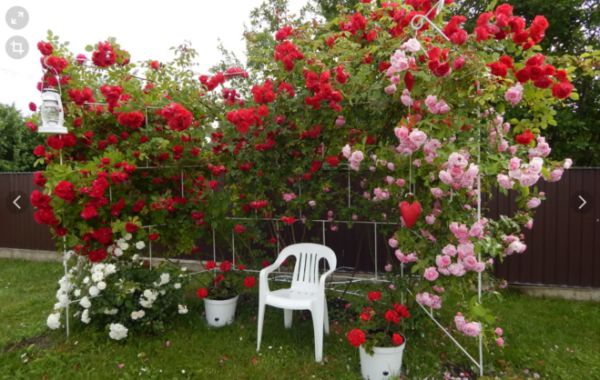

After installing the support, the bush should be tied up with soft garden wire. Subsequently, when the plants grow gradually, it is necessary to raise the shoots and tie the branches to the support.
It is not difficult to take care of roses, even a novice florist will cope with the task. It is recommended not to postpone the events and to conduct them efficiently. With spring care, you get a beautiful flower garden that will delight your eyes and your heart.
Transfer and landing
It often happens that roses grow very much and begin to interfere with the passage (for example, if you planted them near a path or a house). At the same time, due to overgrowth, the shrub begins to lack food, as a result, it blooms poorly or even dies. And all this is because you initially made a mistake when choosing a place for planting it, or simply planted it at the wrong depth (which is why the roses did not take root and began to die).
Of course, there are other, so to speak, external reasons. For example, you urgently need to free up space for a building or you decide to create a beautiful composition elsewhere.
Well, here are the reasons for you to transplant roses to a new location.
Note! The site has a detailed material about how to transplant roses correctly in spring and autumn.


Cutting roses
However, if you want multiply roses in this way (by dividing the bush during the transplant process), then they will be much more effective cuttings in autumn.


How to root a rose from a bouquet
If you were presented with a bouquet of roses for March 8 or another spring holiday, then you can save them and plant them in your garden.
Note! Detailed information about rooting a rose from a presented bouquet set out in this detailed article.


Pruning young and adult bushes: what's the difference
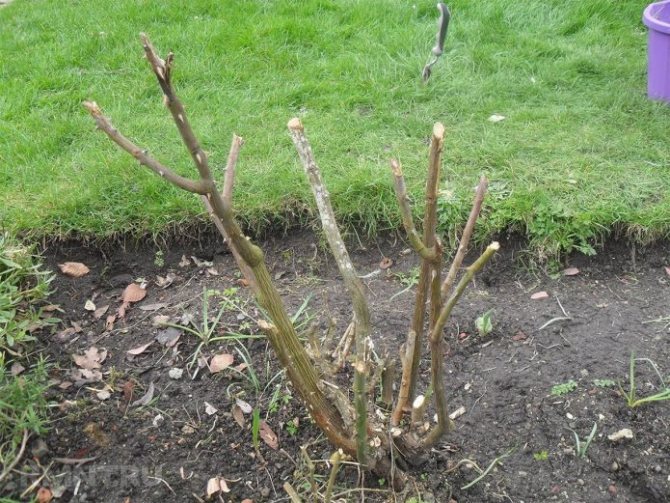

Some gardeners even resort to tool disinfection to protect plants from bacteria.
In rose bushes under the age of one year, the stems are cut to about half. The point of the procedure is to force the plant to use all reserves for root development, and not for foliage. A 2-year-old rose will have 2-3 regeneration branches on which flowers will grow. You cannot cut off these stems, the maximum allowable is to shorten by 2-3 buds in order to fully cover for the winter.
A lush bush can already be formed from a 3-year-old rose. To do this, the stems are cut at different levels, creating a beautiful neat hat.
How to open roses correctly
It is recommended to open rose bushes according to certain rules, which have been tested by time and experience of many flower lovers.
- If the warm spring sun rays melted the tops of the shelter (approximately in the first half of March), and thawed patches began to appear on them, and there is still a lot of snow, then it is necessary to throw snow on these thawed areas again. This is important because the soil is still frozen and the conditions inside the shelter should be cool. After all, if the plants feel the warmth of the sun, the above-ground part will "wake up" and begin to germinate, and the root part will be in the frozen ground. This will inevitably lead to the death of culture.
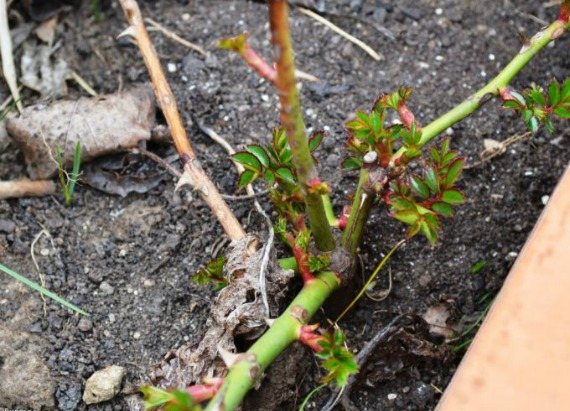

- In conditions of sharp warming and massive melting of snow, the soil is still frozen, it does not have time to warm up as quickly as many would like. In such cases, experienced growers are advised to help rose bushes by spraying wood ash around each plant. This will speed up the freezing process.
- The overwintering of bushes under cover should not be very long, even during a long winter. If it's already April on the calendar, and the area is covered with a lot of snow, then it is recommended to clear it. Rose bushes are contraindicated to be under cover more than they should.
With a sharp warming and massive snow melting, the flow of melt water must be diverted from the crops. To do this, it is necessary to build small channels to drain water next to the shelters.
- With a sharp warming in the shelters, the humidity level rises to the maximum mark, therefore, during this period in the daytime, it is recommended to slightly open the ends of the shelters for one to two hours.
- The duration of daily airing is gradually increased, opening the side as well.
- When a constant daytime temperature is set at twelve to fifteen degrees Celsius and higher, the winter shelter can be removed completely. To do this, experienced flower growers advise choosing a cloudy day (no sun, but no rain) or evening time after sunset so that plants accustomed to dark conditions do not get sunburn.
- Within ten to fifteen days after the opening of the bushes, the plants should get used to the new conditions and be ready for frosts that unexpectedly return at night. To do this, it is advisable to cover all plantings with agrofibre or spruce branches, they will be able to protect from the sun during the day and cold at night during this transition period.
After the establishment of real spring warmth, additional shelters are removed completely and proceed to the main care of the rose bushes.
Other measures for the care of roses in spring
No less important, but still secondary works that are part of the spring rose care activities are the following:
Watering
Roses are very fond of watering. Of course, in the spring, as a rule, they have enough natural moisture, but in no case should you allow the soil in the rose garden to dry out too much. The first watering, as a rule, will be required only after a while and is obligatory only when the weather is stable and warm.
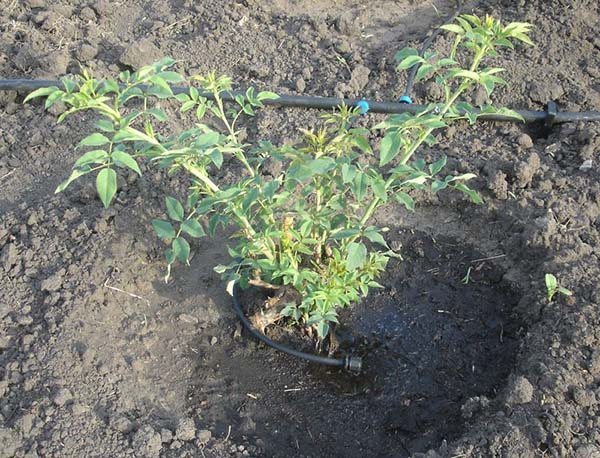

The main indicator (however, this, in principle, should not be brought to this), by which you can determine that the roses are severely lacking in moisture, is the lower leaves.
Naturally, it is advisable to use warm water for irrigation, preferably rainwater. And, of course, watering itself must be carried out exclusively at the root of the plant, no sprinkling is a sure way to fungal diseases.
Although, if you perform light sprinkling in the morning (so that the foliage has time to dry out during the day), then, in principle, it will even be useful for the shrub.
Loosening and weeding
Perhaps why you need to loosen the near-stem circle of roses and other plants is clear to everyone, but we will repeat it again. So, thanks to loosening, the access of air, moisture and nutrition to the roots of the plant is improved.
This is especially important to do after opening the bush after winter.
The very soil around the shrub must be loosened after each watering, and this must be done quite superficially (at a depth of no more than 5 cm) so as not to damage the roots.
Naturally, along with loosening, weeding is also carried out.
Mulching
This is one of the auxiliary agrotechnical techniques that can significantly simplify the care of roses.
Why mulch roses (and other garden crops):
When to take cover
Since roses are thermophilic creatures, in most regions of our country they are sheltered for the winter. In the spring, it is imperative to remove the protective shelter in order to enable the flowers to grow further and develop.
It is necessary to remove the shelter not in one go, but in several stages, gradually. If you jerk off the protection of the bush in one day, the rose may be negatively affected by return frosts. This kind of nighttime cold snaps are characteristic of many climatic zones of Russia. If it is still too cold outside, do not rush to remove the shelter - it will be wiser to wait for stable warm weather.
At first, the end parts of the covering protection are freed from protection. And even then they should not be completely removed, gardeners simply try to make small holes for ventilation. However, this is only in the daytime - at night, the shelter must be returned to its original position.
So, day after day, the period of airing is increased, all new layers of material are revealed. We recommend removing the shelter completely on a cloudy day so that the roses do not get sunburn out of habit.If the weather is stable, sunny, build some kind of awning nearby for temporary shading of the bush.
Timing
In some regions, it becomes quite warm already in March. But this does not mean that with the onset of the first warm days, you should urgently run to get rid of the shelter. March heat is unstable and unstable: by removing the protection, you can simply freeze the plants. But you can't pull to the last: such a tightening reduces the immunity of roses, weakens them.
In general, the timing of the removal of the winter shelter depends on the following factors:
- how much the snow has melted;
- what is the outside temperature;
- to what depth the earth has warmed up;
- whether return frosts have stopped;
- what shelter was made in the fall.
Usually, they begin to remove it when there is no snow in the garden, and the soil warms up a little.
How to feed roses in autumn
Before the autumn treatment of roses with fertilizers is carried out, it is important to take the following measures:
- stop watering flowers so that new shoots do not grow "in autumn";
- do not loosen the ground: otherwise, the abundant flow of oxygen to the root system of the shrub simply will not let it "fall asleep";
- remove all remaining buds and leaves from below, gradually moving higher;
- be sure to do autumn pruning.


It is recommended to start all the main feeding activities after pruning the shrub. Experienced gardeners prefer to feed roses in two stages: the first falls on the last days of August, and the second - already in September-October, before the onset of the first frost. In principle, if someone does not have the opportunity to do this twice, the main thing is to add the necessary substances at least once.
Potassium-containing compounds are used as fertilizers in the autumn. You can feed the flower with sulfate, potassium chloride or potassium-magnesia. Phosphorus is also a necessary substance (both simple and double superphosphates will be useful). Calcium is found in chalk, dolomite flour and slaked lime. Thus, the spectrum of necessary substances becomes clear: with the help of potassium, the rose adapts better to the onset of cold weather, and phosphorus will ensure good ripening of the wood and the appearance of active and healthy shoots in spring.
Fertilizer for irrigation
If we talk about fertilizers specifically for irrigation, the same substances are used here that are sold in the form of granules. Many of them dissolve well in water, but there are some that do not have high dissolution properties. In this case, it is allowed to use liquid or granular fertilizers of your choice. The main thing is that they do not contain nitrogen, because this substance has a stimulating effect and will not contribute to the leaving of the plant during the "hibernation" period necessary for the winter.
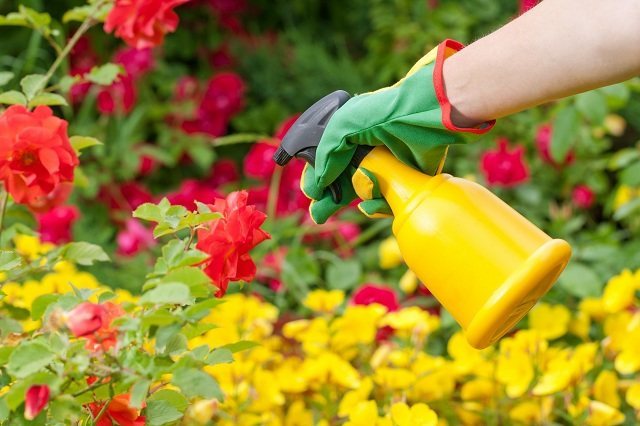

The best option that can be used in liquid form is a finishing dressing for roses. It must be diluted, following the instructions for use, and the composition already contains all the necessary components. However, this fertilizer is not cheap. If the gardener does not have the financial ability to purchase it, you can use potassium monophosphate, which has an excellent ability to dissolve in water. If roses occupy a large area on the site, phosphate simply scatters over the damp ground.
Spraying compound
Treatment of roses in the fall from pests and diseases is carried out by spraying with iron vitriol or ferrous sulfate. It should not be confused with copper sulfate: they are two different chemicals. For prevention, a three percent solution should be used, namely: 30 grams of substance per liter of water (if the area is small), and if you need to process a large number of bushes, the concentration should be observed in the proportion of 300 grams per 10 liters of water.
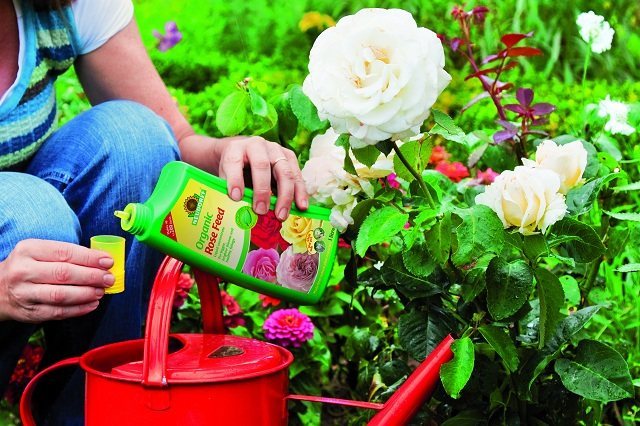

It is impossible to exceed the permissible threshold for the activity of the composition, so as not to harm the delicate flower, but it is also not recommended to reduce the percentage, since a weak solution will not have the desired effect on dangerous fungal spores.
Dry dressing
In order for the flowers to survive the winter safely, fertilizing roses in the fall should include the application of dry fertilizer in the form of wood ash. It contains many beneficial trace elements such as potassium and calcium. Ash should be mixed with compost, which is well quail, and then simply sprinkle the fertilizer around the bushes. Thus, they will also receive protection of the root system from the cold.
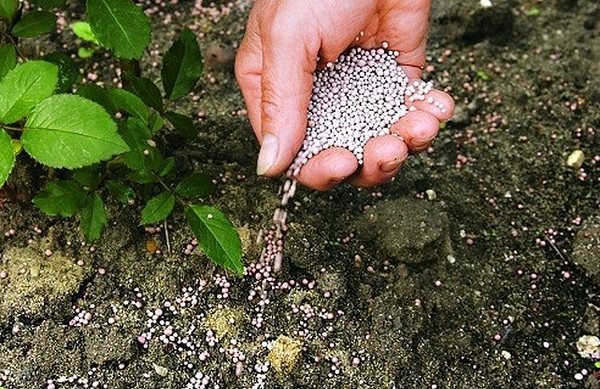

How to cover a climbing rose without removing it from the support. How to keep climbing roses in winter
The safety of climbing roses in winter depends on their correct preparation in autumn and the selection of covering material or a method of shelter. They use different shelter options, which depend mainly on the winter hardiness of the variety of roses, their length and the location.
Preparing climbing roses for winter is one of the responsible care measures for regions with cold climates. Proper cover contributes to better preservation of roses and obtaining high preservation of buds in spring and obtaining abundant flowering.
As a result of selection, new varieties of roses have lost the ability to go into a state of dormancy before the onset of cold weather. As a result, roses before wintering in foliage and with flower buds.
Winter frosts interrupt the growing season and bring roses to a dormant state. But when the temperature rises above zero degrees, the roses resume sap flow and they come out of this state. All this leads to the death of rose bushes during the winter during the period of short-term thaws.
The main factor in the preservation of roses is the presence of an air gap under the shelter. The air gap protects the roses in early spring from getting wet and damp.
Roses are prepared for wintering at the end of summer. Stop loosening, watering and feeding. They begin to cover roses in persistent frosts of more than -5 ° C, since with lower frosts they can germinate and dry out. Light frosts strengthen and harden the roses before wintering.
In dry weather, the plants are removed from the supports, the leaves are removed and the damaged ones are cut off. We tie the whips with a rope and with the help of wooden or metal hooks we press them to the ground, on which dry leaves or spruce branches are laid in advance.
We bend the climbing roses with straight-flow shoots carefully in several steps. For disease-resistant varieties of roses, it is not dangerous to touch the shoots to the covering shields. They are not affected by burns and bark cancer.
Roses that are not resistant to diseases are tied in a tourniquet and bend down. We cover with prepared shields so that they do not touch the walls of the shoots, which leads to various infections. We put wooden shields on bent roses in the form of a roof and forget the pegs on the sides for fixing so that they do not disperse in different directions during heavy snowfalls.
We cover the shields with a plastic wrap of a size sufficient to close the ends. We fix the film well so that the wind does not rip it off.
I leave the ends open until the onset of stable frosts more - 5 degrees. Roses can temporarily withstand temperatures down to -12 degrees. When the soil under the shelter freezes, close the ends and lower the film.
Moisture is dangerous for overwintering roses, so rain and snow should not fall into the shelter. If the snow layer on the shelter is about 10 cm, then the temperature in the shelter, even in severe frosts, will not drop below 8 degrees. During frosts, everything in the shelter breaks with hoarfrost. It lowers the temperature inside the shelter during long thaws to a temperature of 0 degrees, until it melts completely. Then conditions are not created for the appearance of various fungi.
The best condition for wintering roses is when they are in the shelter all the time in a frozen state. Even better and more reliable shelter will be if dry leaves are laid on top of the roses under the shields.It is dangerous if there are mice in the garden.
With prolonged thaws, you can tear off the ends of the shelter to avoid drying out the shoots. If winters are warm, you can leave vents in the shelter for ventilation.
In roses, the trunk, which is stiff and has lost its flexibility, cannot be bent to the ground and covered. Then we make a vertical shelter. After trimming the shoots with a covering material, we insulate and put on the bag upstairs, tie it with a rope, and fix the neck of the bag at the bottom on the trunk.
You can use another method. We stick four sticks around the perimeter of the rose and form a cone above the plant. We tie the crown with a rope and wrap it with hay or straw, fasten it with a rope. We put the burlap on the cone and fix it. You also need to insulate the base and the vaccination site as high as possible, or we sprinkle it with earth.
Curly roses must be removed from the supports before shelter before frost. Lay on boards, pine branches or roofing felt and fix with stakes. When persistent frosts appear, cover with an insulating material and a protective film. All this is securely pinned to the ground.
With the help of spruce branches or covering material, you can cover the roses without removing them from the support. We tie all these covering materials tightly with twine around the lashes of roses.
There are now many frost-resistant varieties of roses that can be left unheated for the winter. Just spud the base at the root system to a height of 25 centimeters.
Mulching
Mulch after spring top dressing.
This event helps the proper development of the plant: it maintains the required moisture level, prevents root erosion and leaching of fertilizers, reduces the number of weeds, maintains looseness of the soil and maintains the temperature regime throughout the year.
Mulching can be carried out regardless of the time of year and the stage of growth of the bush, but the best option, as with fertilization, will be twice a year - in spring and at the end of summer.
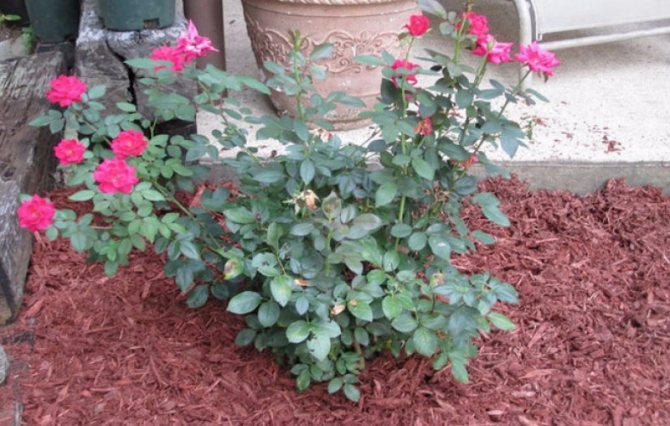

As mulch, you can use both organic (bark, sawdust, hay) and inorganic (gravel, pebbles) materials.
Mulching agrotechnics is simple:
- Free the root area from weeds;
- Cover the soil at the base of the bush with a small layer of mulch, without covering the branches themselves;
- If it is organic mulch, wait for the layer to rot and mix it shallowly with the soil;
- Add a new layer of mulch.
Mulch that suits any type of plant, including roses, is mullein or chicken droppings. In this case, the mulching process is also a fertilizer.
Autumn pruning rules
During the autumn pruning of roses, you should definitely adhere to the following rules so as not to harm the plants:
- use an extremely sharp pruning shear for trimming. A blunt instrument can crush stems, which will take a long time to heal and may die from infection,
- thick shoots do not torment with pruning shears, but cut out with a saw,
- make the cut above the bud that has not had time to germinate, the distance from the cut to the bud should be at least 0.5 cm,
- the cut is made at an angle so that the water does not stand on the wound, but flows down,
- pruning must be done on an external bud, so the shoots will grow without interfering with each other and not thicken the bush,
- damaged and diseased stems should be cut to a white healthy core.
{SOURCE}

